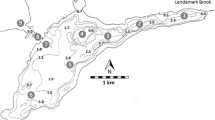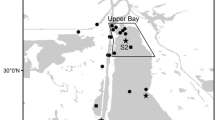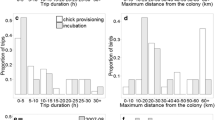Abstract
Inter-sexual differences in reproductive behaviours such as mate choice or parental care may cause sex-bias in movement distances. While this relationship has been extensively studied in birds and mammals, little is known regarding fishes. Fifty-four bullhead (Cottus perifretum), polygamous stream fish with male nest holding, were tracked by means of a portable antenna in a 2,500 m stream reach. Movement was measured at two time scales: monthly movement distance and long-term movement range. Bullhead moved furthest in February and May. In these months, movement distances diversified between the sexes. Females moved significantly furthest in February. This may be related to female mate-choice at the beginning of the reproductive period. In May, at the end of the reproductive period, males moved significantly longer distances. It is speculated that males shift to resource-richer habitats after the starvation during parental care. In general, smaller individuals moved longer distances per month. Long-term movement range did not differ between the sexes but varied considerably between individuals ranging from 1 to 1,111 m. It is concluded that movement studies should encompass an annual time scale as well as a more precise monthly time scale to present an accurate description of sex-biased movement in (annual spawning) fish.

Similar content being viewed by others
References
Austin, D., W. D. Bowen & J. I. McMillan, 2004. Intra-specific variation in movement patterns: modeling individual behaviour in a large marine predator. Oikos 105: 15–30.
Bisazza, A. & A. Marconato, 1988. Female mate choice, male–male competition and parental care in the river bullhead, Cottus gobio L. (Pisces, Cottidae). Animal Behaviour 36: 1352–1360.
Breen, M. J., C. R. Ruetz, K. J. Thompson & S. L. Kohler, 2009. Movements of mottled sculpins (Cottus bairdii) in a Michigan stream: how restricted are they? Canadian Journal of Fisheries and Aquatic Sciences 66: 31–41.
Bruyndoncx, L., G. Knaepkens, W. Meeus, L. Bervoets & M. Eens, 2002. The evaluation of passive integrated transponder (PIT) tags and visible implant elastomer (VIE) marks as new marking techniques for the bullhead. Journal of Fish Biology 60: 260–262.
Clarke, A. L., B.-E. Saether & E. Roskaft, 1997. Sex biases in avian dispersal: a reappraisal. Oikos 79: 429–438.
Clobert, J., J. F. Le Galliard, J. Cote, S. Meylan & M. Massot, 2009. Informed dispersal, heterogeneity in animal dispersal syndromes and the dynamics of spatially structured populations. Ecology Letters 12: 197–209.
Croft, D. P., B. Albanese, B. J. Arrowsmith, M. Botham, M. Webster & J. Krause, 2003. Sex-biased movement in the guppy (Poecilia reticulata). Oecologia 137: 62–68.
Crook, D. A., 2004. Is the home range concept compatible with the movements of two species of lowland river fish? Journal of Animal Ecology 73: 353–366.
Cucherousset, J., J. M. Roussel, R. Keeler, R. A. Cunjak & R. Stump, 2005. The use of two new portable 12-mm PIT tag detectors to track small fish in shallow streams. North American Journal of Fisheries Management 25: 270–274.
Freyhof, J., M. Kottelat & A. Nolte, 2005. Taxonomic diversity of European Cottus with description of eight new species (Teleostei: Cottidae). Ichthyological Exploration of Freshwaters 16: 107–172.
Fujimoto, Y., K. Kurosaka, D. Ojima & M. Iwata, 2008. Habitat use and shift of two sympatric freshwater sculpins (Cottus pollux and Cottus hangiongensis) during the spawning and non-spawning seasons. Journal of Freshwater Ecology 23: 341–346.
Goto, A., 1990. Alternative life-history styles of Japanese freshwater sculpins revisited. Environmental Biology of Fishes 28: 101–112.
Gowan, C., M. K. Young, K. D. Fausch & S. C. Riley, 1994. Restricted movement in resident stream salmonids: a paradigm lost? Canadian Journal of Fisheries and Aquatic Sciences 51: 2626–2637.
Greenwood, P. J., 1980. Mating systems, philopatry and dispersal in birds and mammals. Animal Behaviour 28: 1140–1162.
Hays, G. C., H. Kennedy & B. W. Frost, 2001. Individual variability in diel vertical migration of a marine copepod: why some individuals remain at depth when others migrate. Limnology and Oceanography 46: 2050–2054.
Hudy, M. & J. Shiflet, 2009. Movement and recolonization of Potomac sculpin in a Virginia stream. North American Journal of Fisheries Management 29: 196–204.
Hutchings, J. A. & L. Gerber, 2002. Sex-biased dispersal in a salmonid fish. Proceedings of the Royal Society of London B 269: 2487–2493.
Keeler, R. A., A. R. Breton, D. P. Peterson & R. A. Cunjak, 2007. Apparent survival and detection estimates for PIT-tagged slimy sculpin in five small New Brunswick streams. Transactions of the American Fisheries Society 136: 281–292.
Knaepkens, G., L. Bruyndoncx & M. Eens, 2004. Assessment of residency and movement of the endangered bullhead (Cottus gobio) in two Flemish rivers. Ecology of Freshwater Fish 13: 317–322.
Knaepkens, G., K. Baekelandt & M. Eens, 2005. Assessment of the movement behaviour of the bullhead (Cottus gobio), an endangered European freshwater fish. Animal Biology 55: 219–226.
Knaepkens, G., E. Maerten, C. Tudorache, G. De Boeck & M. Eens, 2007. Evaluation of passive integrated transponder tags for marking the bullhead (Cottus gobio), a small benthic freshwater fish: effects on survival, growth and swimming capacity. Ecology of Freshwater Fish 16: 404–409.
Knight, M. E., M. J. H. Van Oppen, H. L. Smith, C. Rico, G. M. Hewitt & G. F. Turner, 1999. Evidence for male-biased dispersal in Lake Malawi cichlids from microsatellites. Molecular Ecology 8: 1521–1527.
Kobler, A., T. Klefoth, T. Mehner & R. Arlinghaus, 2009. Coexistence of behavioural types in an aquatic top predator: a response to resource limitation? Oecologia 161: 837–847.
Kobler, A., F. A. M. Volckaert, Y. Humblet, G. E. Maes & M. Eens, 2011. Temperament traits and microhabitat use in bullhead, Cottus perifretum; fish associated with complex habitats are less aggressive. Behaviour 148: 603–625.
Kottelat, M. & J. Freyhof, 2007. Handbook of European Freshwater Fishes. Publications Kottelat, Cornol, Switzerland.
Lucas, M. C. & E. Baras, 2001. Migration of Freshwater Fishes. Blackwell Science, Oxford.
Marconato, A. & A. Bisazza, 1986. Males whose nests contain eggs are preferred by female Cottus gobio L. (Pisces, Cottidae). Animal Behaviour 34: 1580–1582.
Marconato, A. & A. Bisazza, 1988. Mate choice, egg cannibalism and reproductive success in the river bullhead, Cottus gobio L. Journal of Fish Biology 33: 905–916.
Marconato, A., A. Bisazza & M. Frabis, 1993. The cost of parental care and egg cannibalism in the river bullhead, Cottus gobio L. (Pisces, Cottidae). Behavioural Ecology and Sociobiology 32: 229–237.
Marentette, J. R., G. Wang, S. Tong, N. M. Sopinka, M. D. Taves, M. A. Koops & S. Balshine, 2011. Laboratory and field evidence of sex-biased movement in the invasive round goby. Behavioural Ecology and Sociobiology 65: 2239–2249.
McLaughlin, R. L., 1989. Search modes of birds and lizards: evidence for alternative movement patterns. American Naturalist 133: 654–670.
McLaughlin, R. L., J. W. A. Grant & D. L. Kramer, 1992. Individual variation and alternative patterns of foraging movements in recently-emerged brook charr (Salvelinus fontinalis). Behaviour 120: 286–301.
Morris, D., 1954. The reproductive behaviour of the river bullhead (Cottus gobio L.) with special reference to the fanning activity. Behaviour 7: 1–32.
Natsumeda, T., 1999. Year-round local movements of the Japanese fluvial sculpin, Cottus pollux (large egg type), with special reference to the distribution of spawning nests. Ichtyological Research 46: 43–48.
Natsumeda, T., 2001. Space use by the Japanese fluvial sculpin, Cottus pollux, related to spatio-temporal limitations in nest resources. Environmental Biology of Fishes 62: 393–400.
Okuda, N., 1999. Female mating strategy and male brood cannibalism in sand-dwelling cardinalfish. Animal Behaviour 58: 273–279.
Ovidio, M., A. Detaille, C. Botninck & J.-C. Phillippart, 2009. Movement behaviour of the small benthic Rhine sculpin Cottus rhenanus (Freyhof, Kottelet & Nolte, 2005) as revealed by radio-telemetry and pit-tagging. Hydrobiologia 636: 119–128.
Pardini, A. T., C. S. Jones, L. R. Noble, B. Kreiser, H. Malcolm, B. D. Bruce, J. D. Stevens, G. Cliff, M. C. Scholl, M. Francis, C. A. J. Duffy & A. P. Martin, 2001. Sex-biased dispersal of great white sharks. Nature 412: 139–140.
Petty, J. T. & G. D. Grossman, 1996. Patch selection by mottled sculpin (Pisces: Cottidae) in a southern Apalachian stream. Freshwater Biology 35: 261–276.
Petty, J. T. & G. D. Grossman, 2004. Restricted movement by mottled sculpin (Pisces: Cottidae) in a southern Appalachian stream. Freshwater Biology 49: 631–645.
Rogers, K. B. & G. C. White, 2007. Analysis of movement and habitat use from telemetry data. In Guy, C. S. & M. L. Brown (eds), Analysis and Interpretation of Freshwater Fisheries Data. American Fisheries Society, Bethesda, MD: 625–676.
Schlosser, I. J. & P. L. Angermeier, 1995. Spatial variation in demographic processes of lotic fishes: conceptual models, empirical evidence, and implications for conservation. American Fisheries Society Symposium 17: 392–401.
Smyly, W. J. P., 1957. The life-history of the bullhead or Miller’s thumb (Cottus gobio L.). Proceedings of the Zoological Society London 128: 431–453.
Whoriskey, F. G., G. J. Fitzgerald & S. G. Reebs, 1986. The breeding-season population structure of three sympatric, territorial sticklebacks (Pisces: Gasterosteidae). Journal of Fish Biology 29: 635–648.
Acknowledgments
The authors thank Geert Eens, Peter Scheys, Sofie Vanwetswinkel, Brecht Engelen and Lennart Damen for their technical assistance; and Guy Knaepkens, Gregory E. Maes and Filip A.M. Volckaert for their support. Many thanks also go to the University of Antwerp and the Fonds Wetenschappelijk Onderzoek—Vlaanderen for funding (FWO-project to Marcel Eens). The handling editor, David J. Hoeinghaus and two anonymous referees provided valuable comments. This experimental study was performed in agreement with the Belgian and Flemish laws and was approved by the ethical committee of the University of Antwerp (ID number 2007/42).
Author information
Authors and Affiliations
Corresponding author
Additional information
Handling editor: David J. Hoeinghaus
Rights and permissions
About this article
Cite this article
Kobler, A., Humblet, Y., Geudens, K. et al. Period-dependent sex-biased movement in a polygamous stream fish (Cottus perifretum Freyhof, Kottelat & Nolte, 2005—Actinopterygii, Cottidae) with male parental care. Hydrobiologia 693, 195–204 (2012). https://doi.org/10.1007/s10750-012-1108-y
Received:
Revised:
Accepted:
Published:
Issue Date:
DOI: https://doi.org/10.1007/s10750-012-1108-y




